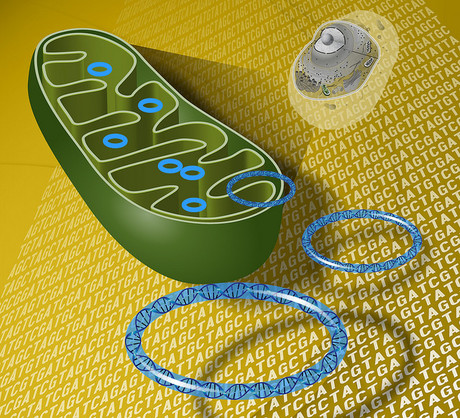How mitochondria withstand attacks on their DNA

Researchers have unravelled the mystery of how mitochondria — the energy generators within cells — withstand attacks on their DNA from rogue molecules. The study was led by the University of Sheffield and has been published in the journal Science Advances.
Mitochondria are the powerhouses of cells, generating the energy required for all cellular activity. They even have their own DNA, which they rely on to produce important proteins for their function. Having healthy mitochondria is essential for tissue regeneration, making it particularly important for successful organ transplants.
During the process of energy production and making proteins, a large number of rogue reactive oxygen species are produced which constantly attack the DNA in mitochondria. But while these attacks do indeed break their DNA, the new findings show that mitochondria have their very own repair kits which are constantly active to maintain their own DNA integrity.
“Each mitochondria repair toolkit has unique components — enzymes — which can cut, hammer and seal the breaks,” said Professor Sherif El-Khamisy, lead author on the study. “The presence of these enzymes is important for energy production.”
The team identified a mechanism through which mtDNA can be damaged and then fixed via a protein called TOP1, which is responsible for untangling coils of mtDNA. When the long strands become tangled, TOP1 breaks and quickly repairs the strands to unravel the knots. However, if free radicals are also attacking the mitochondrial DNA, then TOP1 proteins can become trapped on the mitochondrial DNA strands, making repair even more difficult.
“Defects in repairing DNA breaks in the mitochondria affect vital organs that rely heavily on energy, such as the brain,” said Professor El-Khamisy.
Professor El-Khamisy believes the findings could pave the way for the development of new therapies for mitochondrial disease that boost their DNA repair capacity, or for cancer treatments which could use TDP1 inhibitors to prevent mtDNA repair selectively in cancer cells.
“Cancer relies on cells dividing very quickly,” she noted. “That means they need a lot of energy, so will have really healthy mitochondria.
“If we can find a way to selectively damage the mitochondria in the cancer cells, by preventing or slowing its repair mechanism, this could be really promising.”
The findings could also be important for new clinical advances, such as the decision by the Human Fertilisation and Embryology Authority (HFEA) to allow mitochondrial donation — or ‘three-parent babies’ — where mtDNA from a female donor is introduced to an embryo to correct mitochondrial defects.
“This research suggests that clinicians should assess the function of TDP1 and mitochondrial TOP1 before mitochondrial donation takes place, to ensure the success of this procedure,” said Professor El-Khamisy.
“Even if the new embryo has healthy mitochondrial DNA from the donor, it could still have defective TDP1 or mitochondrial TOP1 from the recipient, since they are both produced by the DNA in the cell’s nucleus, so mitochondrial DNA damage could still take place over time and cause disease.”
Mini lung organoids could help test new treatments
Scientists have developed a simple method for automated the manufacturing of lung organoids...
Clogged 'drains' in the brain an early sign of Alzheimer’s
'Drains' in the brain, responsible for clearing toxic waste in the organ, tend to get...
World's oldest known RNA extracted from woolly mammoth
The RNA sequences are understood to be the oldest ever recovered, coming from mammoth tissue...





